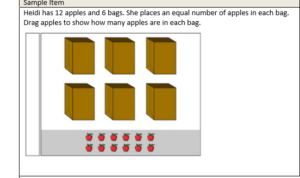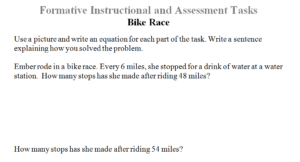Interpret whole-number quotients of whole numbers, e.g., interpret 56 ÷ 8 as the number of objects in each share when 56 objects are partitioned equally into 8 shares, or as a number of shares when 56 objects are partitioned into equal shares of 8 objects each. For example, describe a context in which a number of shares or a number of groups can be expressed as 56 ÷ 8.
[divider] [/divider] Students are able to…
- Use concrete materials to model various division situations.
- Identify the information given in the problem as well as the missing information.
- Use pictorial representations for division situations.
- Connect representations to numeric expressions.
[divider] [/divider] Students are able to…because teachers:
- Provide a variety of division situations for students to model using concrete materials.
- Ask questions that support students identifying information in the problem and connecting it to the division models. What do you know? What do you want to find out?
- Present opportunities for students to explain their reasoning.
- Introduce division symbols and terminology. Add these terms to the class multiplication and division word wall.
[divider] [/divider] Questions to ask students:
- Is this a division or a multiplication problem? How do you know?
- Sample answer that indicates understanding: It is division, because I am taking a total amount of items and separating it into equal groups. I know the number of equal groups and I am solving for the number of items in each group (or, depending on the situation, I know the number of items in each group and I am solving for the number of groups).
- What does each number in the problem represent (the total amount, number of groups or number in each group)?
- Understanding is demonstrated by correctly using the information in the problem to answer the question. For example, in the problem, “There are 24 gum balls in a jar, each party bag is to have 4 gum balls in it. How many party bags can be made?”, understanding would be demonstrated by answering: The 24 is the total amount of gumballs. The 4 is the number of gumballs in each baggy/group. I am solving for the number of baggies/groups.
[divider] [/divider] FSA Notes:
Cognitive Complexity Level: 1 – Recall
Achievement Level Descriptors:
2- interprets whole-number quotients of whole numbers (with a divisor of 1, 2, or 5) using equal groups of objects and arrays of objects
3- interprets whole-number quotients of whole numbers (with factors up to 10) using partitive division; interprets whole number quotients of whole numbers (with factors up to 10) using measurement division
4- interprets quotients of wholenumber division problems within 100, representing context using numbers and word
5- [intentionally left blank]
Assessment Limits:
Whole number quotients and divisors may not exceed 10.
Items may not require students to write an equation to represent a quotient of whole numbers.
[divider] [/divider] Additional Resources:
Additional in depth content knowledge
Blog Post: Understanding Division
Learn Zillion Videos:
Interpreting Division Problems by Drawing Pictures
Visualizing Division Word Problems
[divider] [/divider] Sample Formative Assessment Tasks:
[divider] [/divider] Resources/Tasks to Support Your Child at Home:
Look for real-world examples of situations with items that can be separated into equal groups. For example: candy, cards, toys, cookies etc. (If we baked 12 cookies and the three of us want to share them equally, how many cookies will we each get?)
When your child is solving division problems, ask them:
- How do you know it is a division story problem?
- What is the total amount?
- How many groups are there?
- How many are there in each group?
Learn Zillion Videos:
Interpreting Division Problems by Drawing Pictures
Visualizing Division Word Problems
Math Playground Thinking Blocks: Multiplication and Division https://goo.gl/gnvnyP (Select “Parts and Whole”)

